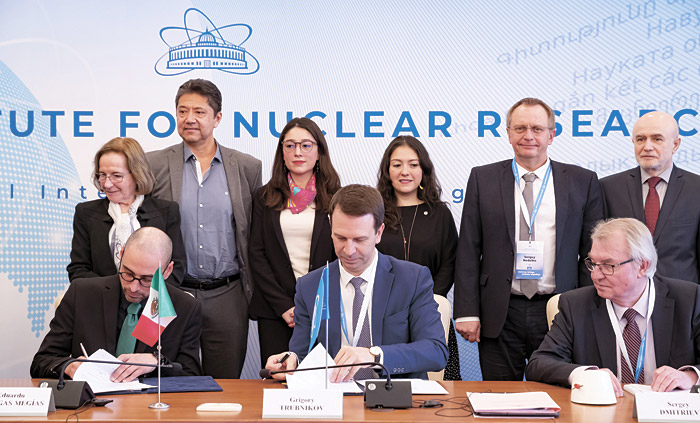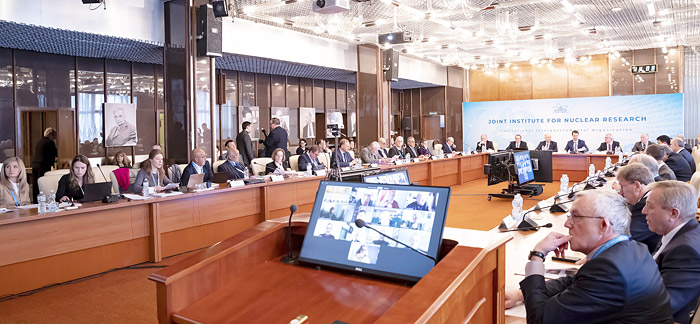
Electronic english version since 2022 |
The newspaper was founded in November 1957
| |
|
Number 7-8 (4655-4656) The special report dedicated to the 110th anniversary of Academician G.N.Flerov: |
At the 133rd session of the JINR Scientific Council
Events, facts, comments
On 16-17 February, the 133rd regular session of the Scientific Council of the Joint Institute for Nuclear Research was held in the JINR Conference Hall chaired by Professor Sergey Kilin. The renewed membership of the Council was approved for a five-year period at the session of the JINR Committee of Plenipotentiaries in November 2022. Director of the Institute gave an overview of the most important scientific results achieved since the September session of the Scientific Council 2022 in his report.
The members of the Council considered and discussed the final version of the new Seven-Year Plan for the Development of JINR that will be approved in March by the Committee of Plenipotentiaries.
Within the framework of the current session of the Scientific Council, an agreement between the Institute and the National Council for Science and Technology of Mexico (on the photo) was solemnly signed aimed at consolidating the areas of mutual scientific interest between JINR and Mexico, as well as outlining specific measures for the future strengthening of cooperation, including the establishment of Joint Coordinating Committee. In January-February, a series of bilateral thematic meetings were held with scientific institutes and universities of China in order to systematize the current large-scale cooperation and to prepare an agreement on cooperation between JINR and P.R.China, as well as to coordinate high-level research.
JINR Director Grigory Trubnikov presented an updated draft of the Seven-Year Plan for the Development of JINR in 2024-2030 to the participants of the session in which the comments and suggestions of the members of the Scientific Council made at the previous session, as well as the results of the discussion of the plan at the CP JINR session in November were taken into account. Thus, the Institute's involvement in external experimental collaborations was prioritized, possible risks for the implementation of the plan were analyzed and ways to overcome them were proposed.

On the same day, reports were delivered by the Chairmen of the Programme Advisory Committees in which the results of the January meetings of the Advisory Bodies of JINR were presented; elections of Directors of FLNP and MLIT were held. Egor Lychagin was elected Director of the Frank Laboratory of Neutron Physics and Sergei Shmatov was elected Director of the Meshcheryakov Laboratory of Information Technologies.
On 17 February, reports were delivered by the young JINR scientists recommended by the PAC, K.A.Alishina and M.Erdauletov at the session.
The Dzhelepov Prize was awarded to P.Yu.Apel (FLNR) for the development of a new generation of track membranes and their application in medicine and ecology. The laureate presented a report on the implemented work.
The Scientific Council approved the decision of the jury on awarding the annual JINR prizes in Research, Physics Instruments and Methods, Applied Physics Research, presented by JINR Vice-Director Vladimir Kekelidze.
The biographies of the new Directors of the Laboratories and the list of laureates of the JINR competition will be published in one of the next issues.

* * *
The plans of the parties to cooperate in the field of advanced fundamental and applied scientific research are outlined in the Joint Declaration of Intent between the National Council for Science and Technology of Mexico (CONACYT) and the Joint Institute for Nuclear Research. The document was signed by CONACYT Director Maria Elena ?lvarez-Buylla Roces on behalf of Mexico. In Dubna, the document was signed by JINR Director Grigory Trubnikov. The solemn signing ceremony was held in the presence of the Ambassador Extraordinary and Plenipotentiary of the United Mexican States to Russia Eduardo Villegas Meg?as.
Commenting on the execution of the document, Grigory Trubnikov noted: "Today, we have concluded an intergovernmental agreement that opens up new horizons for cooperation with Mexico. The scientific programme of the Institute correlates well with the programme of Mexican universities and scientific organizations. This collaboration will open up new opportunities for all the Member States of the Institute." The JINR Director also emphasized that cooperation with Mexico, one of the key countries in Latin America, would give a new impetus to the development of the collaboration of the Joint Institute with Argentina and Brazil.
Eduardo Villegas Mejias expressed his confidence in the success of the collaboration between CONACYT and JINR. "Mexico is ready to take another step towards mutual understanding. We fervently believe in the power of knowledge and have great hopes for a joint future," the ambassador said.
The report of the President of the Mexican Physical Society and Professor of the Institute of Physics of the National Autonomous University of Mexico (UNAM) Ana Maria Cetto Kramis was focused on promising areas for expanding cooperation between Mexico and JINR. Among the areas of potential interest, the speaker outlined the use of synchrotron radiation to study the characteristics of new materials, theoretical and experimental research in the field of plasma physics. In addition, nuclear and radiological safety, dosimetry, as well as radiation physics and chemistry are of mutual interest.
In her comment, Ana Maria Cetto Kramis noted that the signed agreement would allow for mutually enriching cooperation, useful not only for established Mexican scientists, but especially for the younger generation that have a lot to learn at JINR. "The joint declaration of intent is a very significant document, it expresses the will of both parties to work together and commit themselves to the implementation of the plans. This is not the first step in our cooperation with JINR, it has been going on for several years within the framework of the NICA project, but the agreement will significantly expand the possibilities for cooperation. We are very optimistic about the future of our cooperation!" she said.
* * *
JINR Vice-Director, RAS Corresponding Member Vladimir Kekelidze tells about the history of this cooperation:
- Relations with Mexican colleagues at JINR were established long ago. The first were theoretical physicists - the most mobile scientists. There is no need to conclude agreements, mutual interest is enough. We met, exchanged results, collaborated remotely. The real collaboration started when Mexican colleagues knocked on the door of our NICA project and showed interest in the MPD project. In 2019, this process was initiated by Alejandro Ayala that represents the UNAM Institute for Nuclear Research, the largest university in Mexico. He invited us to visit him and our delegation that included Adam Kisiel, Alexander Sorin and myself, visited universities, met with teachers, students, professors and we saw firstly, the high level of both education and the research that is carried out there and secondly, the desire to get involved in our project. First, we signed five agreements and then the sixth one, a memorandum on the participation of six Mexican universities in the MPD experiment. These six universities actually committed themselves to participate in our MPD collaboration with a certain contribution, primarily intellectual, as well as to work with the detectors of this facility.
This was only the first step. I must say that Mexico is a large country, it is one of the top twenty countries in the world in terms of GDP, with a population of more than 120 million people, with a fairly high level of education. Maybe, science is not yet so highly developed but today, they seek to develop both fundamental and applied research at the modern level and in this regard, their involvement in the orbit of JINR is important for the development of our Institute for the mission that it carries: science should bring nations together.
And so, the next step was taken. There were some efforts initiated by us and supported by Ana Maria Cetto Kramis. She is a very famous woman - she has been a member of Directorate of the Pugwash movement, IAEA and a number of other international organizations. She is currently the President of the Mexican Physical Society, a member of our Scientific Council and a very active supporter for Mexico to eventually become a member of our Institute. With her great assistance, with the support of Alejandro Ayala and our other friends from Mexico, the National Council for Science and Technology of Mexico has signed a declaration of intent in order to move towards bringing us closer to both the Mexican scientific community and the country as a whole. And at the meeting of the Scientific Council, in a solemn atmosphere, in the presence of representatives of Mexico, Director of the Institute Grigory Trubnikov affixed his signature on our part, thereby securing the bilateral declaration that opens the way for the reunification of Mexico with the family of 16 countries widely participating in the activities of the Institute.
Mexican scientists are very open, friendly, like all the people of this country. And I think that we will enrich our Institute by welcoming such a community into our family, firstly, quite powerful and secondly, very constructive and forward-looking.
* * *
Each session of the Scientific Council is just the tip of the iceberg that floats to the surface twice a year. The scientific and organizational work does not stop for a single day. And who, if not Chairman of the session, elected from among the members of the Council, should evaluate its work? Shortly before the end of the session, Chairman Academician of the National Academy of Sciences of the Republic of Belarus Sergey Kilin sums up the results:
"Many events took place at this very productive session. First of all, the membership was renewed. There are new members from Mexico and China. The activity of the members of the Scientific Council is very high and what is especially striking, the interest of our colleagues from non-CIS countries in joint activities within the framework of the Joint Institute has become more significant. An agreement has been signed with colleagues from Mexico. Cooperation with JINR expands on the part of Brazil, South Africa, Vietnam and China. That is, it is clear that the Joint Institute performs its function as a coordinator of scientific research.
Since the session was held in a mixed format, the members of the Scientific Council working remotely took an active part both in the discussion of the papers and in the formulation of the paragraphs of the final document, the resolution.
And there is one thing we have learnt about. The achievements highlighted in the JINR Director's report at this session, first of all, the first physical data obtained in experiments at the NICA complex are of a fundamental character. But in order to achieve these results, an unusually serious technological work is required at the very forefront. Therefore, the outcome of all these conversations, arguments over whether fundamental science is needed or not, is clearly illustrated by how, as an engine of technological development, these absolutely new fundamental results are obtained. And to this I will add that colleagues at the Joint Institute try (and they succeed!) to attract young people that are happy to work here. And the JINR infrastructure successfully develops in accordance with the outlined plans.
The Seven-Year Programme for the Development of the Institute in 2024-2030 was the major focus of the agenda of this session of the Scientific Council. This document has been carefully prepared and discussed at different levels. It will be presented for final discussion at the autumn session of the Scientific Council.
Material by Evgeny MOLCHANOV,
Photo by Elena PUZYNINA